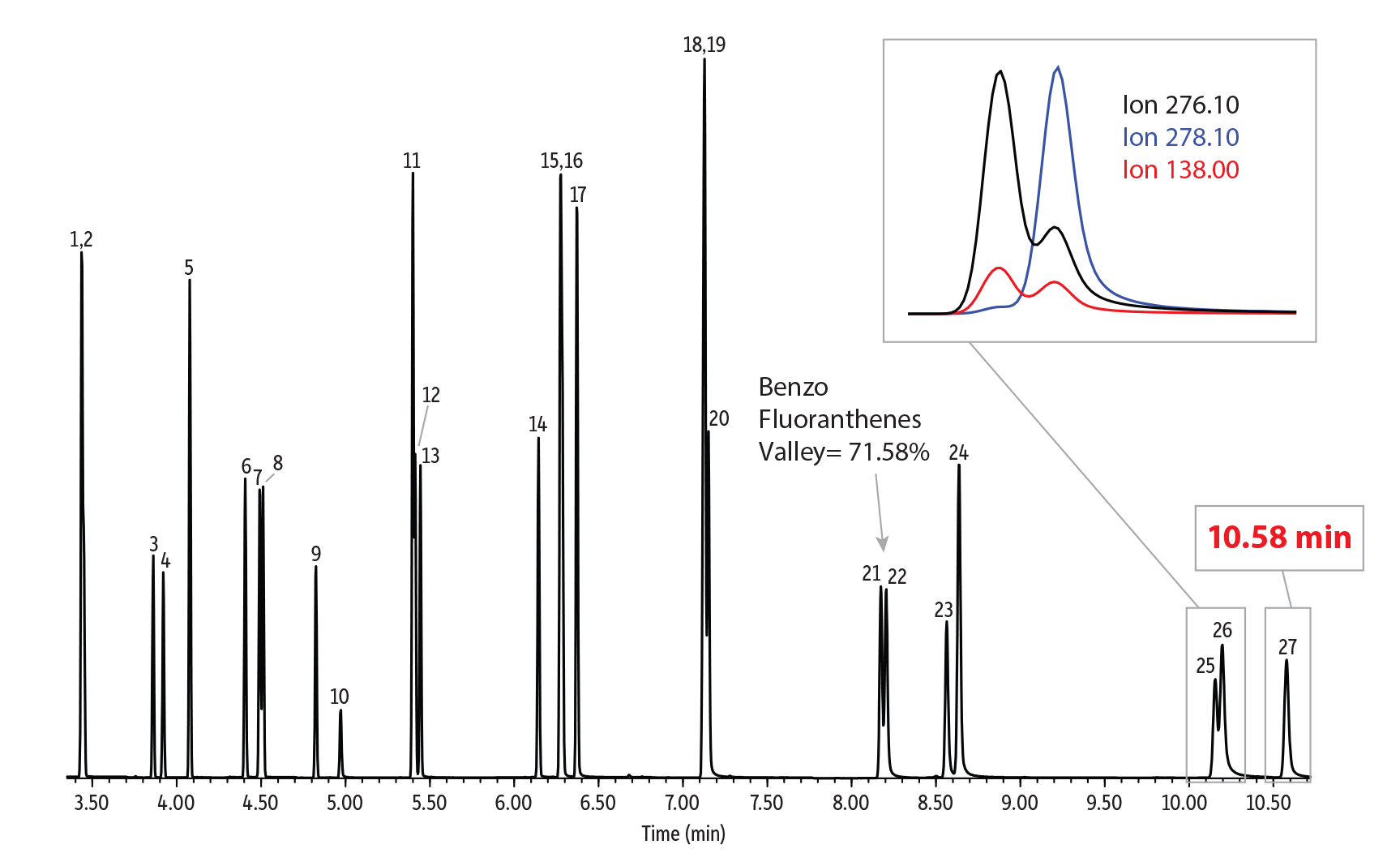Increase Sample Throughput with New 15-Minute, Low-Level PAH GC-MS Analysis
Featured Application: Fast PAH Analysis at Low Levels Using the GC Accelerator Kit
- Scaled-down column and method open the door to faster PAH analysis; the GC Accelerator kit boosts oven ramp rates to meet the demands of scaled-down methods.
- Use your existing semivolatiles method in SIM mode for low-level PAH analysis.
- Reduce overall cycle time to increase sample throughput.
Fast, low-level analysis of polycyclic aromatic hydrocarbons (PAHs) is of global interest because of the high toxicity and carcinogenic properties of some of these compounds. For GC-MS analyses, the structure of PAHs lends them to analysis in the more sensitive, though selective, selected ion monitoring (SIM) mode because they commonly ionize without significant fragmentation under typical electron ionization conditions, resulting in strong molecular ion signals. This makes it easy to convert an existing semivolatile compound analysis, like U.S. EPA 8270D, that is typically run in full scan mode, to a SIM analysis that is able to detect even lower levels of PAHs.
The PAH GC-MS analysis shown here takes advantage of scaling the traditional column format (30 m, 0.25 mm, 0.25 µm Rxi-5Sil MS) down to a shorter, more efficient column that yields the same separations in less time (20 m, 0.15 mm, 0.15 µm Rxi-5Sil MS). The optimized scaled-down method parameters presented below ensure the elution profile on the new column format will remain the same as is typically observed on the traditional column. For Agilent 6890 and 7890 instruments with 120 V ovens that are not able to meet the ramp rates in the scaled-down analysis, Restek’s GC Accelerator kit was used to boost the GC’s ramp rate capability without any changes to the hardware or software.
As shown in the chromatogram, this PAH GC-MS analysis resulted in good peak resolution and response even at 0.05 ng on-column with just 15 minutes of analysis time. Anytime low-level PAHs are analyzed, particular care should be taken to mitigate the peak tailing that can result from the MS temperatures being set too low or from not using optimized source parts for the application. For example, in this case using a 9 mm extractor lens is recommended instead of the standard 3 mm version. Note that at particularly low concentrations, calibration may require alternate fit types, but internal testing demonstrated that method calibration requirements could still be met.

| Peaks | tR (min) | Conc. (µg/mL) | |
|---|---|---|---|
| 1. | Naphthalene-d8 (IS) | 3.44 | 2.0 |
| 2. | Naphthalene | 3.45 | 1.0 |
| 3. | 2-Methylnaphthalene | 3.86 | 1.0 |
| 4. | 1-Methylnaphthalene | 3.92 | 1.0 |
| 5. | 2-Fluorobiphenyl (SS) | 4.08 | 2.0 |
| 6. | Acenaphthylene | 4.41 | 1.0 |
| 7. | Acenaphthene-d10 (IS) | 4.49 | 2.0 |
| 8. | Acenaphthene | 4.51 | 1.0 |
| 9. | Fluorene | 4.83 | 1.0 |
| 10. | 2,4,6-Tribromophenol (SS) | 4.97 | 2.0 |
| 11. | Phenanthrene-d10 (IS) | 5.40 | 2.0 |
| 12. | Phenanthrene | 5.41 | 1.0 |
| 13. | Anthracene | 5.45 | 1.0 |
| Peaks | tR (min) | Conc. (µg/mL) | |
|---|---|---|---|
| 14. | Fluoranthene | 6.15 | 1.0 |
| 15. | Pyrene-d10 (SS) | 6.28 | 2.0 |
| 16. | Pyrene | 6.29 | 1.0 |
| 17. | p-Terphenyl-D14 (SS) | 6.37 | 2.0 |
| 18. | Benz[a]anthracene | 7.12 | 1.0 |
| 19. | Chrysene-d12 (IS) | 7.13 | 2.0 |
| 20. | Chrysene | 7.15 | 1.0 |
| 21. | Benzo[b]fluoranthene | 8.17 | 1.0 |
| 22. | Benzo[k]fluoranthene | 8.21 | 1.0 |
| 23. | Benzo[a]pyrene | 8.56 | 1.0 |
| 24. | Perylene-d12 (IS) | 8.64 | 2.0 |
| 25. | Indeno[1,2,3-cd]pyrene | 10.16 | 1.0 |
| 26. | Dibenz[a,h]anthracene | 10.20 | 1.0 |
| 27. | Benzo[ghi]perylene | 10.58 | 1.0 |
| Column | Rxi-5Sil MS, 20 m, 0.15 mm ID, 0.15 µm (cat.# 43816) |
|---|---|
| Standard/Sample | EPA Method 8310 PAH mixture (cat.# 31874) |
| Revised SV internal standard mix (cat.# 31886) | |
| Revised B/N surrogate mix (cat.# 31888) | |
| Acid surrogate mix (4/89 SOW) (cat.# 31063) | |
| Diluent: | Dichloromethane |
| Injection | |
| Inj. Vol.: | 1.0 µL split (split ratio 20:1) |
| Liner: | Topaz 4 mm single taper w/wool (cat.# 23303) |
| Inj. Temp.: | 275 °C |
| Oven | |
| Oven Temp.: | 60 °C (hold 0.7 min) to 285 °C at 39.8 °C/min to 305 °C at 4.3 °C/min to 320 °C at 28.5 °C/min (hold 3.5 min) |
| Carrier Gas | He, constant flow |
| Flow Rate: | 1.0 mL/min |
| Detector | MS | ||||||||||||||||||||||||||||||||||||||||||||
|---|---|---|---|---|---|---|---|---|---|---|---|---|---|---|---|---|---|---|---|---|---|---|---|---|---|---|---|---|---|---|---|---|---|---|---|---|---|---|---|---|---|---|---|---|---|
| Mode: | SIM | ||||||||||||||||||||||||||||||||||||||||||||
| SIM Program: | |||||||||||||||||||||||||||||||||||||||||||||
| |||||||||||||||||||||||||||||||||||||||||||||
| Transfer Line Temp.: | 280 °C | ||||||||||||||||||||||||||||||||||||||||||||
| Analyzer Type: | Quadrupole | ||||||||||||||||||||||||||||||||||||||||||||
| Source Type: | Extractor | ||||||||||||||||||||||||||||||||||||||||||||
| Extractor Lens: | 9 mm ID | ||||||||||||||||||||||||||||||||||||||||||||
| Source Temp.: | 330 °C | ||||||||||||||||||||||||||||||||||||||||||||
| Quad Temp.: | 180 °C | ||||||||||||||||||||||||||||||||||||||||||||
| Solvent Delay Time: | 1 min | ||||||||||||||||||||||||||||||||||||||||||||
| Tune Type: | DFTPP | ||||||||||||||||||||||||||||||||||||||||||||
| Ionization Mode: | EI | ||||||||||||||||||||||||||||||||||||||||||||
| Instrument | Agilent 7890B GC & 5977A MSD | ||||||||||||||||||||||||||||||||||||||||||||
| Notes | Fast SIM analysis of 16 priority PAHs plus the methylnaphthalenes in a 120 V oven equipped with the GC Accelerator kit (cat.# 23849) (injected 1 µg/mL = 0.05 ng on-column). | ||||||||||||||||||||||||||||||||||||||||||||

